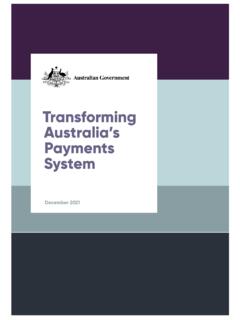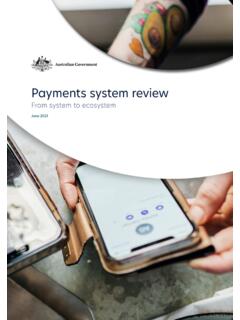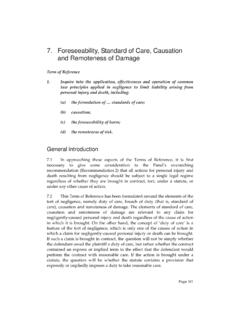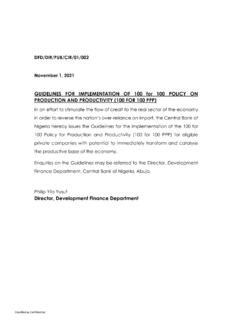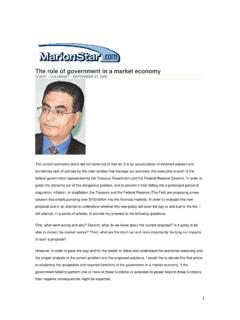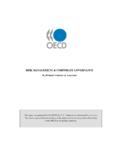Transcription of Understanding the appreciation of the Australian dollar ...
1 Understanding the appreciation of the Australian dollar and its policy implications Phil Garton, Danial Gaudry, and Rhett Wilcox1. The Australian dollar has appreciated strongly over the past decade, leading to increased concerns over the impacts of the high exchange rate on trade-exposed sectors of the economy. This paper examines the underlying drivers of this rise, the exchange rate's role as a macroeconomic shock absorber and the implications of various policy options that might be directed at reducing the exchange rate. 1 The authors are from Macroeconomic Policy Division, the Australian Treasury.
2 This article has benefited from comments and suggestions provided by James Kelly, Shane Johnson and David Gruen. The views in this article are those of the authors and not necessarily those of the Australian Treasury. 39. Understanding the appreciation of the Australian dollar and its policy implications Introduction Over the past decade, the Australian dollar (AUD) has appreciated strongly against the US dollar (USD), rising from less than US $ in 2001 to a peak of over US $ in 2011. While the rise can be attributed to a number of factors, the mining boom has been the key driver of the appreciation over this period.
3 The AUD has remained well above its post-float average for a number of years, and has generally been around or above parity against the USD since October 2010, when it reached parity for the first time since it was floated in December 1983. The prolonged high level of the currency has led to significant debate regarding its effects on the Australian economy. Indeed, there have been calls for Australia to reconsider the long-standing policy of allowing the AUD to float relatively freely. Against this backdrop, this paper examines the factors determining the value of the AUD and its role in the macroeconomy more broadly.
4 It also discusses the implications of various policy options that might be directed at reducing the exchange rate. Measuring the exchange rate The value of the AUD is generally reported as a nominal bilateral rate, which is the rate at which one unit of currency can be exchanged for another. Given that the USD is a global major currency, the AUD/USD cross rate receives the most attention. An alternative measure is an effective exchange rate, which is a trade-weighted average of bilateral exchange rates. Generally this provides a more informative measure of the value of the AUD, particularly when bilateral exchange rates exhibit diverging trends (RBA 2002).
5 A commonly-cited measure is the trade-weighted index (TWI) published by the Reserve Bank of Australia (RBA), which weights the currencies of Australia's largest trading partners by their shares of Australia's trade. Both the TWI and the USD exchange rates are important measures. The TWI provides a more accurate reflection of overall trade competitiveness as it includes the exchange rates of all our major trading partners. The USD exchange rate is also important as a significant proportion of Australia's trade is denominated in USDs, even if the United States is not a direct participant in the transaction.
6 Another measure of the exchange rate is the real effective exchange rate, which is the trade-weighted nominal exchange rate multiplied by the ratio of Australian prices to our trading partners' price levels. Since trade competitiveness is ultimately determined by changes in the relative price of Australian goods and services in terms of foreign goods and services, the real exchange rate is conceptually a better measure of trade competitiveness. 40. Understanding the appreciation of the Australian dollar and its policy implications A commonly used measure of the real effective exchange rate is the RBA's real TWI, which uses the core consumer price index (CPI) measure of price levels (which excludes food and energy).
7 There are also alternative weighting schemes. Movements in trade-weighted measures such as the real TWI provide only a rough measure of changes in Australia's trade competitiveness, since weights based on trade shares do not capture changes in prices relative to countries that are competing suppliers to our exports in third countries (Ellis 2001). The economic role of the exchange rate In an open economy, the exchange rate is a key economy-wide relative price that helps to maintain equilibrium across both the financial and real sides of the economy. The exchange rate along with other variables such as interest rates, output and prices.
8 Adjusts to simultaneously equate demand and supply in the foreign exchange market, other financial markets, and goods and services markets. Most importantly, movements in the nominal exchange rate play a critical role in allowing the real economy to adjust to shocks while limiting the impacts on macroeconomic stability . As the currency normally appreciates (depreciates) in response to shocks that have a stimulatory (contractionary) impact on the economy, the exchange rate functions as an automatic stabiliser that helps keep the economy growing at a rate consistent with its non-inflationary level of capacity utilisation (full employment).
9 For instance, a shock that boosts demand for Australian goods requires domestic prices to rise relative to foreign prices (that is, a real exchange rate appreciation ) unless there is substantial spare capacity in the This brings demand and supply into line by shifting spending from domestic to foreign goods and by promoting increased supply of domestic goods. Similarly, a shock that reduces demand for Australian goods will require a real depreciation. Under a flexible exchange rate regime, where monetary policy targets low inflation, these relative price movements occur mainly through the nominal exchange rate.
10 This is closely linked to the operation of monetary policy, as the exchange rate tends to appreciate (depreciate) when domestic interest rates rise (fall) relative to foreign interest rates. When the economy is strong (weak), monetary policy will be tighter 2 Unless otherwise stated, impacts on the exchange rate are discussed on the assumption that other things are unchanged, including in the rest of the world. A shock with identical effects on Australia and our trading partners would not affect the exchange rate. Hence, the exchange rate only helps adjustment to shocks that are asymmetric'.


